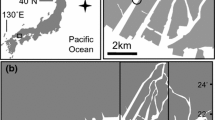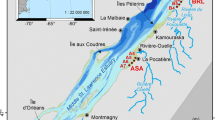Abstract
Within the Guadalquivir estuary, young recruits of marine species seem to respond to changes in freshwater flow by moving with the mass of estuarine water that is most “suitable” for them. The control of the river flow, from a dam 110 km upstream from the river mouth, has an immediate effect on the estuarine salinity gradient, displacing it either seaward or upstream. Consequently, there is a reduction or enlargement of the estuarine area that is used as nursery grounds. The analysis of the temporal estuarine recruitment and spatial distribution of young stages of marine species, during six annual cycles, provides evidence that the estuarine zone used as nursery grounds is mainly that part situated seaward from an isohaline value of 5. The relationship between the position of that isohaline (D5) and the freshwater discharges from the dam was also examined during high and low tides. It was found that a high percentage of the isohaline position variation (75% and 73% at high and low tides, respectively) can be explained by the freshwater volume discharged from the dam during the previous week. These preliminary results suggest that an accurate model of the relationship between these two variables may be a useful tool for future management strategies of freshwater discharges to the estuary.






Similar content being viewed by others
References
Baldó, F., J. A. Cuesta, C. Fernández-Delgado & P. Drake, 2005. Efecto de la regulación del caudal del Río Guadalquivir sobre las características físico-químicas del agua y la macrofauna acuática de su estuario. Ciencias Marinas 31: 467–476.
Baldó, F. & P. Drake, 2002. A multivariate approach to the feeding habits of small fishes in the Guadalquivir estuary. Journal of Fish Biology 61: 21–32.
Baldó, F., L. J. Taracido, A. M. Arias & P. Drake, 2001. Distribution and life history of the mysid Rhopalophthalmus mediterraneus in the Guadalquivir estuary (SW Spain). Journal of the Crustacean Biology 21: 961–972.
Barletta, M., A. Barletta-Bergan, U. St.-Paul & G. Hulbolds, 2005. The role of salinity in structuring the fish assemblages in a tropical estuary. Journal of Fish Biology 66: 45–72.
Bernát, N., B. Köpcke, S. Yasseri, R. Thiel & K. Wolfstein, 1994. Tidal variation in bacteria, phytoplankton, zooplankton, mysids, fish and suspended particulate matter in the turbidity zone of the Elbe estuary; interrelationships and causes. Netherlands Journal of Aquatic Ecology 28: 467–476.
Castel, J., 1993. Long-term distribution of zooplankton in the Gironde estuary and its relation with river flow and suspended matter. Cahiers de Biologie Marine 34: 45–163.
Dando, P. R. & N. Demir, 1985. On the spawning and nursery ground of bass, Dicentrarchus labrax in the Plymouth area. Journal of the Marine Biological Association of the United Kingdom 65: 159–168.
David, V., B. Sautour, P. Chardy & M. Leconte, 2005. Long-term changes of the zooplankton variability in a turbid environment: the Gironde estuary (France). Estuarine, Coastal and Shelf Science 64: 171–184.
Drake, P., A. M. Arias, F. Baldó, J. A. Cuesta, A. Rodríguez, A. Silva-García, I. Sobrino, D. García-González & C. Fernández-Delgado, 2002. Spatial and temporal variation of the nekton and hyperbenthos from a temperate European estuary with a regulated freshwater inflow. Estuaries 25: 451–468.
Elliott, M., K. L. Hemingway, M. J. Costello, S. Duhamel, K. Hostens, M. Lapropoulou, S. Marshall & H. Winkler, 2000. Links between fish and other trophic levels. In Elliott, M. & K. L. Hemingway (eds), Fishes in Estuaries. Blackwell Science, Oxford, 124–216.
Fernandez-Delgado, C., P. Drake, A. M. Arias & D. García-González, 2000. Peces de Doñana y su entorno. Organismo Autónomo Parques Nacionales, Ministerio de Medio Ambiente, Madrid.
Govoni, J. J., 1997. The association of the population recruitment of gulf menhaden, Brevoortia patronus, with Mississippi river discharge. Journal of Marine Systems 12: 101–108.
Jassby, A. D., J. E. Cloern & B. E. Cole, 2002. Annual primary production: patterns and mechanisms of change in a nutrient-rich tidal ecosystem. Limnology and Oceanography 47: 698–712.
Jassby, A. D., W. J. Kimmerer, S. G. Monismith, C. Armor, J. E. Cloern, T. M. Powell, J. R. Schubel & T. J. Vendlinski, 1995. Isohaline position as a habitat indicator for estuarine population. Ecological Applications 5: 272–289.
Kimmel, D. G. & M. R. Roman, 2004. Long-term trends in mesozooplankton abundance in Chesapeake Bay, USA: influence of freshwater input. Marine Ecology Progress Series 267: 71–83.
Kimmerer, W. J., 2002. Effects of freshwater flow on abundance of estuarine organisms: physical effects or trophic linkages? Marine Ecology Progress Series 243: 39–55.
Maes, J., P. A. van Damme, A. Taillieu & F. Ollevier, 1998. Fish communities along an oxygen-poor salinity gradient (Zeeschelde estuary, Belgium). Journal of Fish Biology 52: 534–546.
Marchand, J., 1988. Distributions saisonnières, abondances et diversités de l’ichthyofaune de l’estuaire interne de la Loire en 1977–1978. Annales de l’Institut Océanographique 56: 127–137.
Marshall, S. & M. Elliott, 1998. Environmental influences on the fish assemblage of the Humber estuary, U.K. Estuarine. Coastal and Shelf Science 46: 175–184.
Peterson, M. S. & S. T. Ross, 1991. Dynamics of littoral fishes and decapods along a coastal river-estuarine gradient. Estuarine, Coastal and Shelf Science 33: 467-483.
Rakocinski, C. F., D. M. Baltz & J. W. Fleeger, 1992. Correspondence between environmental gradients and the community structure of marsh-edge fishes in a Louisiana estuary. Marine Ecology Progress Series 80: 135–148.
Schlacher, T. & T. H. Wooldridge, 1996. Ecological responses to reductions in freshwater supply and quality in South Africa’s estuaries: lessons for management and conservation. Journal of Costal Conservation 2: 115–130.
Sobrino, I., F. Baldó, D. García-González, J. A. Cuesta, A. Silva-García, C. Fernández-Delgado, A. M. Arias, A. Rodríguez & P. Drake, 2005. The effect of estuarine fisheries on juvenile fish observed within the Guadalquivir Estuary (SW Spain). Fisheries Research 76: 229–242.
Thiel, R., A. Sepúlveda, R. Kafemann & F. Nellen, 1995. Environmental factors as forces structuring the fish community of the Elbe estuary. Journal of Fish Biology 46: 47–49.
Vannéy, J. R., 1970. L´hydrologie du bas Guadalquivir. Instituto de Geografía Aplicada del Patronato “Alonso de Herrera”, Madrid.
Vieira, M. E. C. & A. A. Bordalo, 2000. The Douro estuary (Portugal): a mesotidal salt wedge. Oceanologica Acta 23: 585–594.
Wagner, C. M., 1999. Expression of the estuarine species minimum in littoral fish assemblages of the lower Chesapeake Bay tributaries. Estuaries 22: 304–312.
Wagner, C. M. & H. M. Austin, 1999. Correspondence between environmental gradients and summer littoral fish assemblages in low salinity reaches of the Chesapeake Bay, USA. Marine Ecology Progress Series 177: 197–212.
Acknowledgements
The authors wish to thank Manuel Ruiz Sánchez for sampling assistance and Mariana Espigares for their assistance in processing samples. Our gratitude is extended to the “Confederación Hidrográfica del Guadalquivir” that provided us the daily caudal discharged from the dam. The study was supported by the Environmental Agency of Autonomous Andalusian Government (Consejería de Medio Ambiente; Junta de Andalucía) and MCYT project REN2000–0822 MAR.
Author information
Authors and Affiliations
Corresponding author
Rights and permissions
About this article
Cite this article
Fernández-Delgado, C., Baldó, F., Vilas, C. et al. Effects of the river discharge management on the nursery function of the Guadalquivir river estuary (SW Spain). Hydrobiologia 587, 125–136 (2007). https://doi.org/10.1007/s10750-007-0691-9
Issue Date:
DOI: https://doi.org/10.1007/s10750-007-0691-9




